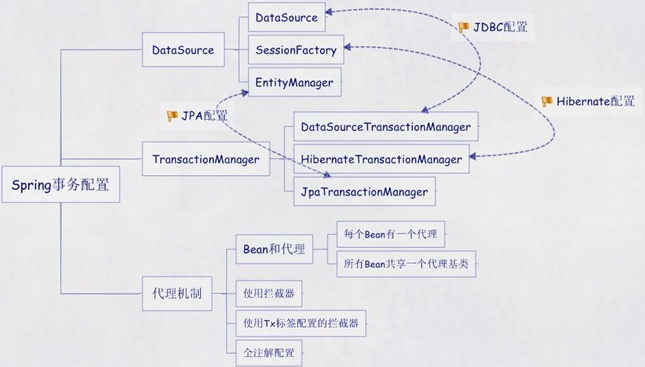Spring配置文件中关于事务配置总是由三个组成部分,分别是DataSource、TransactionManager和代理机制这三部分,无论哪种配置方式,一般变化的只是代理机制这部分。
DataSource、TransactionManager这两部分只是会根据数据访问方式有所变化,比如使用Hibernate进行数据访问时,DataSource实际为SessionFactory,TransactionManager的实现为HibernateTransactionManager。
具体如下图:
一:每个Bean都有一个代理
<?xml version="1.0" encoding="UTF-8"?>
<beans xmlns="http://www.springframework.org/schema/beans"
xmlns:xsi="http://www.w3.org/2001/XMLSchema-instance"
xmlns:context="http://www.springframework.org/schema/context"
xmlns:aop="http://www.springframework.org/schema/aop"
xsi:schemaLocation="http://www.springframework.org/schema/beans
http://www.springframework.org/schema/beans/spring-beans-2.5.xsd
http://www.springframework.org/schema/context
http://www.springframework.org/schema/context/spring-context-2.5.xsd
http://www.springframework.org/schema/aop http://www.springframework.org/schema/aop/spring-aop-2.5.xsd">
<bean id="sessionFactory"
class="org.springframework.orm.hibernate3.LocalSessionFactoryBean">
<property name="configLocation" value="classpath:hibernate.cfg.xml" />
<property name="configurationClass" value="org.hibernate.cfg.AnnotationConfiguration" />
</bean>
<!-- 定义事务管理器(声明式的事务) -->
<bean id="transactionManager"
class="org.springframework.orm.hibernate3.HibernateTransactionManager">
<property name="sessionFactory" ref="sessionFactory" />
</bean>
<!-- 配置DAO -->
<bean id="userDaoTarget" class="com.bluesky.spring.dao.UserDaoImpl">
<property name="sessionFactory" ref="sessionFactory" />
</bean>
<bean id="userDao"
class="org.springframework.transaction.interceptor.TransactionProxyFactoryBean">
<!-- 配置事务管理器 -->
<property name="transactionManager" ref="transactionManager" />
<property name="target" ref="userDaoTarget" />
<property name="proxyInterfaces" value="com.bluesky.spring.dao.GeneratorDao" />
<!-- 配置事务属性 -->
<property name="transactionAttributes">
<props>
<prop key="*">PROPAGATION_REQUIRED</prop>
</props>
</property>
</bean>
</beans>
二:所有Bean共享一个代理基类
<?xml version="1.0" encoding="UTF-8"?>
<beans xmlns="http://www.springframework.org/schema/beans"
xmlns:xsi="http://www.w3.org/2001/XMLSchema-instance"
xmlns:context="http://www.springframework.org/schema/context"
xmlns:aop="http://www.springframework.org/schema/aop"
xsi:schemaLocation="http://www.springframework.org/schema/beans
http://www.springframework.org/schema/beans/spring-beans-2.5.xsd
http://www.springframework.org/schema/context
http://www.springframework.org/schema/context/spring-context-2.5.xsd
http://www.springframework.org/schema/aop http://www.springframework.org/schema/aop/spring-aop-2.5.xsd">
<bean id="sessionFactory"
class="org.springframework.orm.hibernate3.LocalSessionFactoryBean">
<property name="configLocation" value="classpath:hibernate.cfg.xml" />
<property name="configurationClass" value="org.hibernate.cfg.AnnotationConfiguration" />
</bean>
<!-- 定义事务管理器(声明式的事务) -->
<bean id="transactionManager"
class="org.springframework.orm.hibernate3.HibernateTransactionManager">
<property name="sessionFactory" ref="sessionFactory" />
</bean>
<bean id="transactionBase"
class="org.springframework.transaction.interceptor.TransactionProxyFactoryBean"
lazy-init="true" abstract="true">
<!-- 配置事务管理器 -->
<property name="transactionManager" ref="transactionManager" />
<!-- 配置事务属性 -->
<property name="transactionAttributes">
<props>
<prop key="*">PROPAGATION_REQUIRED</prop>
</props>
</property>
</bean>
<!-- 配置DAO -->
<bean id="userDaoTarget" class="com.bluesky.spring.dao.UserDaoImpl">
<property name="sessionFactory" ref="sessionFactory" />
</bean>
<bean id="userDao" parent="transactionBase" >
<property name="target" ref="userDaoTarget" />
</bean>
</beans>
三:使用拦截器
<?xml version="1.0" encoding="UTF-8"?>
<beans xmlns="http://www.springframework.org/schema/beans"
xmlns:xsi="http://www.w3.org/2001/XMLSchema-instance"
xmlns:context="http://www.springframework.org/schema/context"
xmlns:aop="http://www.springframework.org/schema/aop"
xsi:schemaLocation="http://www.springframework.org/schema/beans
http://www.springframework.org/schema/beans/spring-beans-2.5.xsd
http://www.springframework.org/schema/context
http://www.springframework.org/schema/context/spring-context-2.5.xsd
http://www.springframework.org/schema/aop http://www.springframework.org/schema/aop/spring-aop-2.5.xsd">
<bean id="sessionFactory"
class="org.springframework.orm.hibernate3.LocalSessionFactoryBean">
<property name="configLocation" value="classpath:hibernate.cfg.xml" />
<property name="configurationClass" value="org.hibernate.cfg.AnnotationConfiguration" />
</bean>
<!-- 定义事务管理器(声明式的事务) -->
<bean id="transactionManager"
class="org.springframework.orm.hibernate3.HibernateTransactionManager">
<property name="sessionFactory" ref="sessionFactory" />
</bean>
<bean id="transactionInterceptor"
class="org.springframework.transaction.interceptor.TransactionInterceptor">
<property name="transactionManager" ref="transactionManager" />
<!-- 配置事务属性 -->
<property name="transactionAttributes">
<props>
<prop key="*">PROPAGATION_REQUIRED</prop>
</props>
</property>
</bean>
<bean class="org.springframework.aop.framework.autoproxy.BeanNameAutoProxyCreator">
<property name="beanNames">
<list>
<value>*Dao</value>
</list>
</property>
<property name="interceptorNames">
<list>
<value>transactionInterceptor</value>
</list>
</property>
</bean>
<!-- 配置DAO -->
<bean id="userDao" class="com.bluesky.spring.dao.UserDaoImpl">
<property name="sessionFactory" ref="sessionFactory" />
</bean>
</beans>
四:使用tx标签配置的拦截器(也是最常用的)
<?xml version="1.0" encoding="UTF-8"?>
<beans xmlns="http://www.springframework.org/schema/beans"
xmlns:xsi="http://www.w3.org/2001/XMLSchema-instance"
xmlns:context="http://www.springframework.org/schema/context"
xmlns:aop="http://www.springframework.org/schema/aop"
xmlns:tx="http://www.springframework.org/schema/tx"
xsi:schemaLocation="http://www.springframework.org/schema/beans
http://www.springframework.org/schema/beans/spring-beans-2.5.xsd
http://www.springframework.org/schema/context
http://www.springframework.org/schema/context/spring-context-2.5.xsd
http://www.springframework.org/schema/aop http://www.springframework.org/schema/aop/spring-aop-2.5.xsd
http://www.springframework.org/schema/tx http://www.springframework.org/schema/tx/spring-tx-2.5.xsd">
<context:annotation-config />
<context:component-scan base-package="com.bluesky" />
<bean id="sessionFactory"
class="org.springframework.orm.hibernate3.LocalSessionFactoryBean">
<property name="configLocation" value="classpath:hibernate.cfg.xml" />
<property name="configurationClass" value="org.hibernate.cfg.AnnotationConfiguration" />
</bean>
<!-- 定义事务管理器(声明式的事务) -->
<bean id="transactionManager"
class="org.springframework.orm.hibernate3.HibernateTransactionManager">
<property name="sessionFactory" ref="sessionFactory" />
</bean>
<tx:advice id="txAdvice" transaction-manager="transactionManager">
<tx:attributes>
<tx:method name="*" propagation="REQUIRED" />
</tx:attributes>
</tx:advice>
<aop:config>
<aop:pointcut id="interceptorPointCuts"
expression="execution(* com.bluesky.spring.dao.*.*(..))" />
<aop:advisor advice-ref="txAdvice"
pointcut-ref="interceptorPointCuts" />
</aop:config>
</beans>
五:全注解
<?xml version="1.0" encoding="UTF-8"?>
<beans xmlns="http://www.springframework.org/schema/beans"
xmlns:xsi="http://www.w3.org/2001/XMLSchema-instance"
xmlns:context="http://www.springframework.org/schema/context"
xmlns:aop="http://www.springframework.org/schema/aop"
xmlns:tx="http://www.springframework.org/schema/tx"
xsi:schemaLocation="http://www.springframework.org/schema/beans
http://www.springframework.org/schema/beans/spring-beans-2.5.xsd
http://www.springframework.org/schema/context
http://www.springframework.org/schema/context/spring-context-2.5.xsd
http://www.springframework.org/schema/aop http://www.springframework.org/schema/aop/spring-aop-2.5.xsd
http://www.springframework.org/schema/tx http://www.springframework.org/schema/tx/spring-tx-2.5.xsd">
<context:annotation-config />
<context:component-scan base-package="com.bluesky" />
<tx:annotation-driven transaction-manager="transactionManager"/>
<bean id="sessionFactory"
class="org.springframework.orm.hibernate3.LocalSessionFactoryBean">
<property name="configLocation" value="classpath:hibernate.cfg.xml" />
<property name="configurationClass" value="org.hibernate.cfg.AnnotationConfiguration" />
</bean>
<!-- 定义事务管理器(声明式的事务) -->
<bean id="transactionManager"
class="org.springframework.orm.hibernate3.HibernateTransactionManager">
<property name="sessionFactory" ref="sessionFactory" />
</bean>
</beans>
此时在DAO上需加上@Transactional注解,如下:
package com.spring.dao;
import java.util.List;
import org.hibernate.SessionFactory;
import org.springframework.beans.factory.annotation.Autowired;
import org.springframework.orm.hibernate3.support.HibernateDaoSupport;
import org.springframework.stereotype.Component;
import com.spring.domain.User;
@Transactional
@Component("userDao")
public class UserDaoImpl extends HibernateDaoSupport implements UserDao {
public List<User> listUsers() {
return this.getSession().createQuery("from User").list();
}
...
}








相关推荐
本篇文章将深入探讨Spring事务管理的五种方法,旨在帮助开发者更好地理解和运用这一核心特性。 首先,我们来了解什么是事务。在数据库操作中,事务是一组逻辑操作,这些操作要么全部成功,要么全部失败,确保数据的...
Spring 3.0 提供了两种事务管理配置方法:基于 XML 的事务管理和基于 @Transactional 的事务管理,这两种方法都是为了实现事务管理的目标,分别具有不同的配置方式和优缺点。 基于 XML 的事务管理 这种方法不需要...
### Spring事务配置的五种方式详解 #### 一、引言 在企业级应用开发中,事务处理是非常重要的一部分,特别是在涉及多个数据库操作时。Spring框架提供了强大的事务管理功能,支持编程式和声明式两种事务处理方式。...
Spring声明式事务配置管理方法
Spring事务原理是指Spring框架中的一种机制,用于管理事务,并提供了多种配置方式。事务是指一系列的操作,作为一个整体执行,如果其中某个操作失败,整个事务将回滚。Spring事务原理围绕着两个核心:...
总的来说,掌握 Spring 事务管理的五种配置方式,有助于我们在开发中更好地控制事务边界,保证数据的一致性和完整性。理解并灵活运用这些知识,能够提升我们的代码质量,降低系统风险,提高系统的稳定性和可靠性。
Spring 事务配置是Spring框架中不可或缺的部分,它用于管理和协调应用程序中的事务边界,确保数据的一致性和完整性。在Spring中,事务配置主要涉及到三个核心组件:DataSource、TransactionManager以及代理机制。...
下面将详细介绍Spring的五种事务配置方式。 1. **基于XML的事务配置** - **每个Bean都有一个代理**: 在这种配置方式中,每个需要事务管理的Bean都会有一个对应的代理Bean。例如,对于DAO层的UserDao,我们首先...
本文将深入探讨Spring中的几种事务配置方式,帮助开发者更好地理解和运用。 1. **编程式事务管理** 编程式事务管理是在代码中显式调用事务API来控制事务的开始、提交、回滚等操作。这种方式直接在业务逻辑代码中...
### Spring事务与数据库操作 #### 一、Spring的声明式事务管理 在现代软件开发中,事务处理是非常关键的一部分,特别是在涉及多个数据操作时。Spring框架提供了强大的事务管理能力,可以方便地集成到应用程序中。...
Spring事务管理的目的是确保数据的一致性和完整性,尤其是在多操作、多资源的环境中。本Demo将深入探讨Spring如何实现事务的管理。 首先,Spring提供了两种主要的事务管理方式:编程式事务管理和声明式事务管理。 ...
测试spring事务管理 搭建了ssh框架的web工程 本工程用到的数据库表很简单 user(id, name) 可自行创建 本例所有的事务放在service层进行管理,方法中间抛出运行时异常以测试是否回滚 Spring配置文件中关于事务...
本文将详细介绍Spring事务配置的五种方式,帮助你深入理解如何在Spring应用中管理事务。 1. **基于XML的声明式事务管理** 第一种方式是在每个Bean上使用代理来实现事务管理。首先,配置`DataSource`,通常是`...
Spring事务配置的五种方法 Spring配置文件中关于事务配置总是由三个组成部分,分别是DataSource、TransactionManager和代理机制这三部分,无论哪种配置方式,一般变化的只是代理机制这部分。 DataSource、...
Spring AOP 配置事务方法提供了一种灵活的方式来实现事务管理,通过配置事务特性和事务管理切面来实现事务管理。开发者可以根据需要配置事务管理器、数据源连接池和事务特性来实现特定的事务管理需求。
在Spring框架中,事务管理是核心特性之一,用于确保数据操作的一致性和完整性。当一个方法(A方法)内部调用另一个方法(B方法)时,可能会遇到事务控制...这个示例代码对于理解和调试Spring事务管理的问题非常有帮助。
这样,带有@Transactional注解的类或方法将会自动地被Spring事务代理处理。 3. **编程式事务管理** 编程式事务管理允许在代码中显式地开始、提交、回滚事务。使用PlatformTransactionManager接口的实现,如...
本篇文章将详细解析Spring中的六种事务配置方法,帮助开发者深入理解并掌握Spring事务的运用。 1. **基于XML的事务配置** Spring支持通过XML配置来管理事务,这是最基础的配置方式。在`spring`的配置文件中,我们...
在Spring 1.x中,声明式事务有两种主要的配置方式,第一种是通过XML配置逐个为每个业务类创建事务代理。首先,你需要声明一个事务管理器,如`HibernateTransactionManager`,然后定义业务层的bean,并为其创建一个...